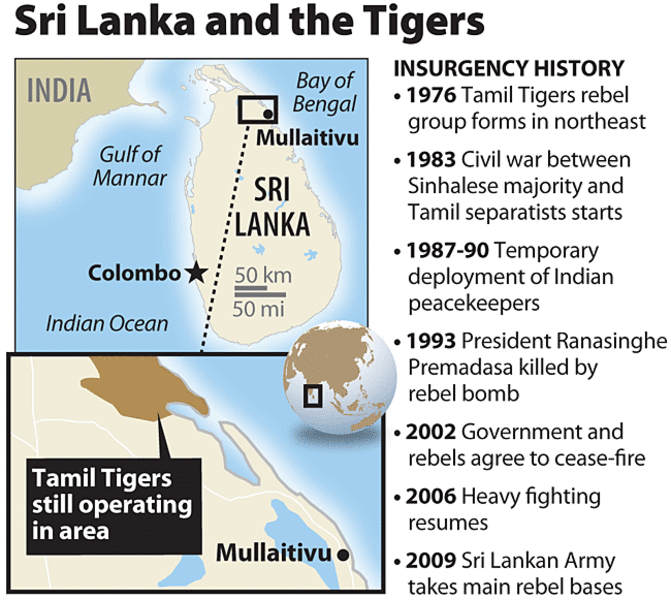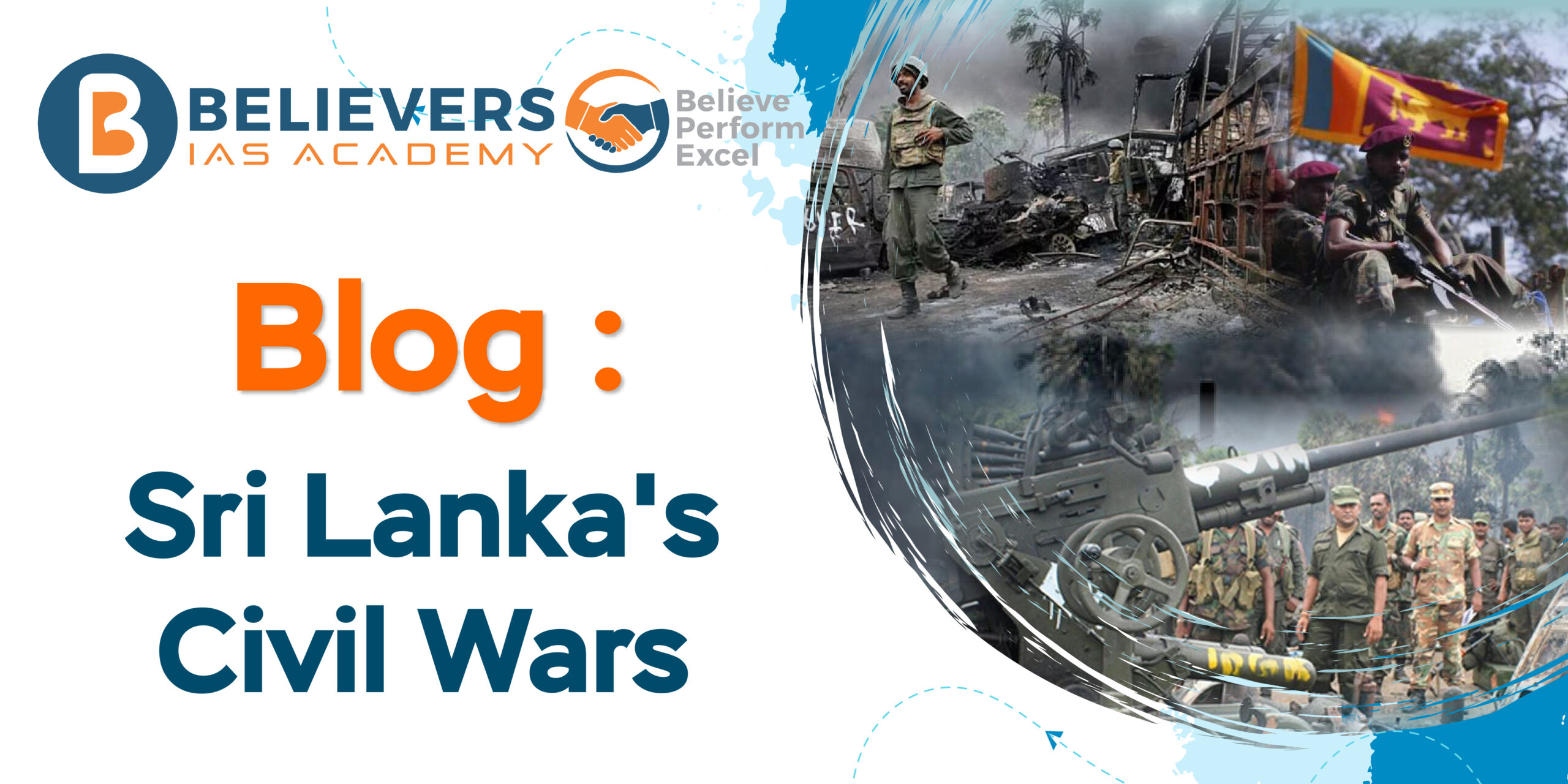Sri Lankan Civil War
The Liberation Tigers of Tamil Eelam (LTTE), a militant separatist organization, and the Sri Lankan government engaged in an armed war between 1983 and 2009 that was known as the Sri Lankan Civil War. The dominant Sinhalese group, which controlled the government, and the Tamil minority community engaged in the war primarily for racial and political grievances.
What was the Historical background of the Civil War?
Before Independence:
- British Colonial Rule: The “divide and rule” technique was used throughout the British colonial era, escalating tensions between the Sinhalese majority and the Tamil minority.
- English Education and Civil Service Opportunities: The American Ceylon Mission created English language schools in Jaffna, which benefited the local Tamil community. As English education was required for employment in the civil service, the Jaffna Tamil upper castes were able to get more civil service opportunities than the Sinhalese.
- Allegations of Favoritism: According to certain accounts, the British gave favour to the Tamil people, which resulted in a higher proportion of Tamils working in the state sector compared to their population. Others, such as S. W. R. D. Bandaranaike and historian E. F. C. Ludowyk, contend that Tamils’ supremacy in the public sector was the result of their dedication and talent.
- Discrimination and Frustration: Because of the educational and economic disparities they experienced while living under colonial authority, the majority of Sinhalese who did not speak English felt both prejudiced against and disappointed.
- Christianity’s supremacy and English privilege: The British drove Buddhism, the predominant religion practised by the Sinhalese, to the margins of governmental administration. The policies that gave the English-speaking community preferential treatment made the non-English-speaking people, particularly the Sinhalese, more dissatisfied.
- Post-Colonial Ethic Tension: Ethnic animosity between the Tamils of Sri Lanka and the Sinhalese increased when British colonial control ended.
After Independence
- Ceylon Citizenship Act (1948): Sri Lanka adopted a contentious law following its independence in 1948 that discriminated against the Indian Tamil ethnic minority and made it challenging for them to get citizenship. Deportation to India followed the statelessness of a large number of Indian Tamils.
- Sinhala Only Act (1956): Under the “Sinhala Only Act,” introduced by Prime Minister S. W. R. D. Bandaranaike, Sinhala became the sole official language of the nation, replacing English. Minorities who speak Tamil viewed this as discriminatory.
- standardization Policy (1970s): Sri Lankan Tamil students suffered from the government’s uniformity of university admissions policy, which decreased their participation in higher education.
- State-Sponsored Colonization: To exacerbate ethnic tensions, the government encouraged Sinhalese peasants to colonize historic Tamil areas.
- Formation of Tamil Militant Group: Tamil youth, particularly Velupillai Prabhakaran, created militant groups like the Tamil New Tigers (TNT) and later the Liberation Tigers of Tamil Eelam (LTTE) in response to these discriminatory laws and acts.
- Tamil United Liberation Front (TULF): The TULF was established in 1976 and advocated for the establishment of Tamil Eelam as a separate state based on the principle of self-determination.
- Escalation: Confrontational politics intensified, escalating to the point of bloodshed and armed war between the Sinhalese and Tamil communities.
How did the Civil War Unfold?
Starting Phase
- Independence and Discrimination: In 1948, Ceylon (now Sri Lanka) declared its independence from British colonial control. The new government implemented policies that neglected the Tamil minority and favoured the Sinhalese majority. Making Sinhalese the official tongue and restricting Tamil representation in the civil service and other government jobs are examples of these discriminatory policies.
- statelessness of Indian Tamils: The Ceylon Citizenship Act of 1948, which was passed after the British imported Indian Tamils to the island as plantation labourers, essentially prohibited them from getting citizenship. As a result, almost 700,000 Indian Tamils lost their statehood and were denied official recognition in the land where they had resided for centuries.
- rage and Tensions: The Tamil community’s resentment and rage were fostered by the nation’s discriminatory legislation and the statelessness of Indian Tamils. Future wars are being prepared for by the escalating ethnic tensions between the Sinhalese and the Tamils.
- Civil War (1983): The Sri Lankan Civil War started as a low-intensity insurrection in July 1983. Following an attack by Tamil Tiger terrorists that resulted in the deaths of 13 army personnel, racial unrest erupted in Colombo and other towns. Sinhalese mobs engaged in deadly retaliatory actions against Tamil people as retribution, killing between 2,500 and 3,000 Tamils.
- India’s Involvement: As the violence grew worse, Indian Prime Minister Indira Gandhi proposed acting as a mediator to broker a deal between the Sri Lankan government and the Tamil insurgency. However, tensions between India and Sri Lanka grew when it was discovered that the Indian government was arming and training Tamil insurgents in camps in southern India.
- Violence Increasing: Both sides continued to use aggressive methods as the dispute got worse. Significant losses were caused by the use of landmines, car bombs, and suitcase bombs by Tamil terrorists on Sinhalese military and civilian targets. Following this, the Sri Lankan military retaliated harshly, collecting up Tamil youngsters, accusing them of being tortured, and committing disappearances.
India’s Intervention
- India’s Intervention: To mediate and stop the civil conflict raging between the Sri Lankan government and the Liberation Tigers of Tamil Eelam (LTTE), also known as the Tamil Tigers, in 1987, Indian Prime Minister Rajiv Gandhi sent a peacekeeping force to Sri Lanka. Concerns over separatist sentiments among Tamils in India’s state of Tamil Nadu and a potential refugee catastrophe from Sri Lanka were the main drivers driving India’s engagement.
- Peace Keeping force: About 100,000 Indian soldiers were sent on a peacekeeping mission to neutralize insurgents on both sides and establish a favourable environment for peace negotiations. The operation was code-named Operation Pawan
- The conflict escalated: The Indian peacekeeping force had trouble disarming the Tamil Tigers, failing to accomplish its primary goals. As tensions rose, the Tigers aggressively started to oppose the disarmament initiatives. They attacked the Indian forces, employing young soldiers and female suicide bombers among other weapons.
- Withdrawal of troops: Indian troops were withdrawn because of the mission’s numerous difficulties and declining popularity in India. Ranasinghe Premadasa, the president of Sri Lanka who replaced J.R. Jayewardene, was successful in getting India to remove its peacekeeping forces in May 1990. After 1,200 Indian soldiers lost their lives in fights with Tamil separatists, it was decided to call the troops home.
- Rajiv Gandhi Assassination: Rajiv Gandhi was slain in May of 1991 after returning to India by a female Tamil suicide bomber by the name of Thenmozhi Rajaratnam (also known as Dhanu). The murder was retaliation for India’s involvement in the conflict and its engagement in Sri Lanka.
- Escalating Violence: After India withdrew, the Sri Lankan Civil War raged on for several more years, killing thousands of people and seriously damaging infrastructure.
- President assassination: President Premadasa was also slain in a bombing by the LTTE in May 1993, killing Ranasinghe Premadasa of Sri Lanka.
Second Eelam War:

- Started after peacekeepers withdrew from Sri Lanka’s Civil War.
- Tamil Tigers (LTTE) seized 600-700 Sinhalese police officers in the Eastern Province on June 11, 1990.
- Tigers promised no harm but then executed the police officers.
- The government responded with aerial bombardment and blockade of the Tamil stronghold in Jaffna.
- Retaliatory massacres occurred against Sinhalese, Muslims, and Tamils in the region.
- The bloodiest battle occurred at Elephant Pass in July 1991, with heavy casualties on both sides.
- Government troops couldn’t capture Jaffna despite repeated assaults.
Third Eelam War:
- Tamil Tigers signed a peace agreement with President Chandrika Kumaratunga’s government in January 1995.
- Tigers violated the agreement by bombing naval gunboats in April 1995.
- The government declared a “war for peace” and intensified military operations.
- Tamil refugees and LTTE guerrillas fled to the Vanni region after losing Jaffna in December 1995.
- Tigers launched a successful assault on Mullaitivu in July 1996, killing over 1,200 government soldiers.
- Suicide bombings in Colombo and other cities caused further chaos and loss of life.
- Tiger’s ceasefire in December 2000 raised hopes for peace but was rescinded in April 2001.
- Conflict continued with violence and attacks on civilian and military targets.
The long road to Peace
- Peacemaking Efforts: Through the mediation of Norway, negotiations between the Sri Lankan government and the Tamil Tigers took place in 2002 and 2003. They signed a Memorandum of Understanding and decided on a federal solution as a compromise between the government’s insistence on a unitary state and the Tamils’ demand for a two-state solution.
- Resumption of hostilities: Despite the first ceasefire, hostilities continued, and both sides repeatedly broke the ceasefire. Following the 2004 Indian Ocean Tsunami, disagreements developed regarding the delivery of supplies. When the Tamil Tigers killed Sri Lankan Foreign Minister Lakshman Kadirgamar in 2005, they lost support from the rest of the world.
- Conflict Rekindled: After the peace talks broke down, violence picked back up, resulting in bombings, assassinations, and attacks on civilian targets on both sides. Many civilians died as a result of the government’s offensives against the Tigers.
- End of the conflict: The conflict came to an end in May 2009 when the Sri Lankan government pronounced victory over the Tamil Tigers following a string of significant military offensives. The LTTE admitted defeat as well. Over 100,000 people are thought to have died as a result of the battle.
- War Crimes: During the conflict, atrocities such as attacking civilians, summary killings, and other atrocities were allegedly committed by both the government troops and the Tamil Tigers. There were cries for those accountable to face the consequences of their deeds.



